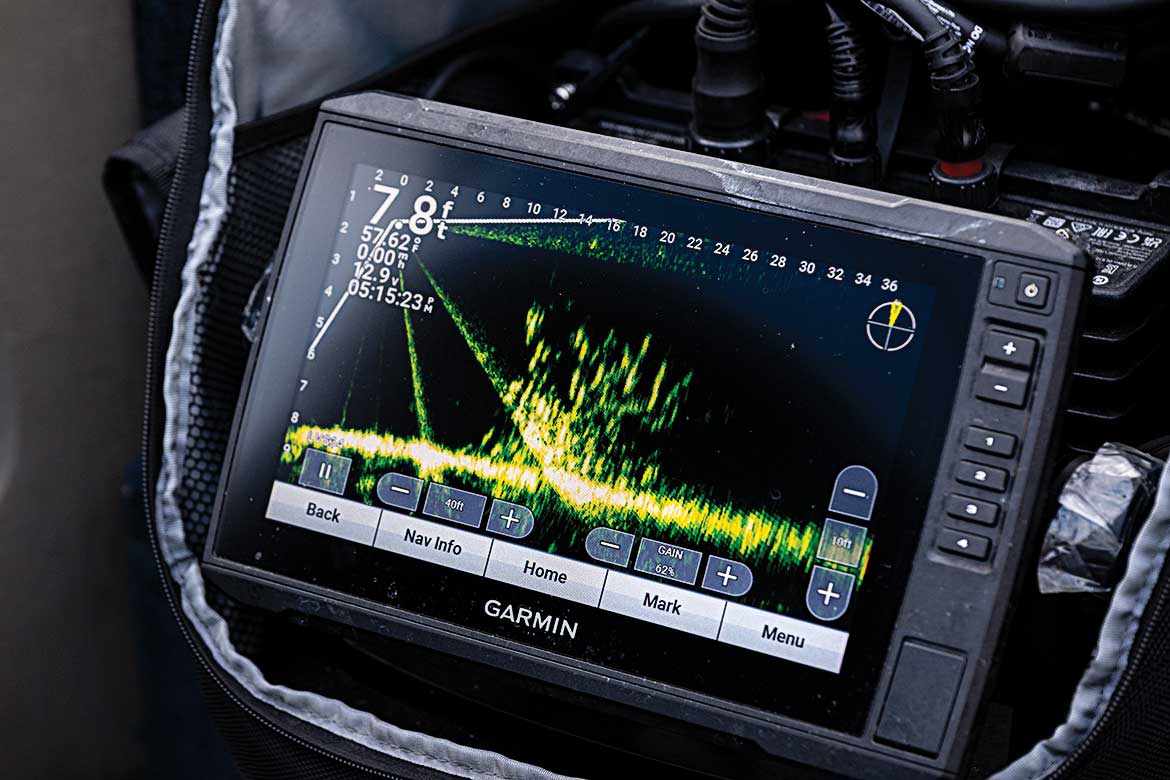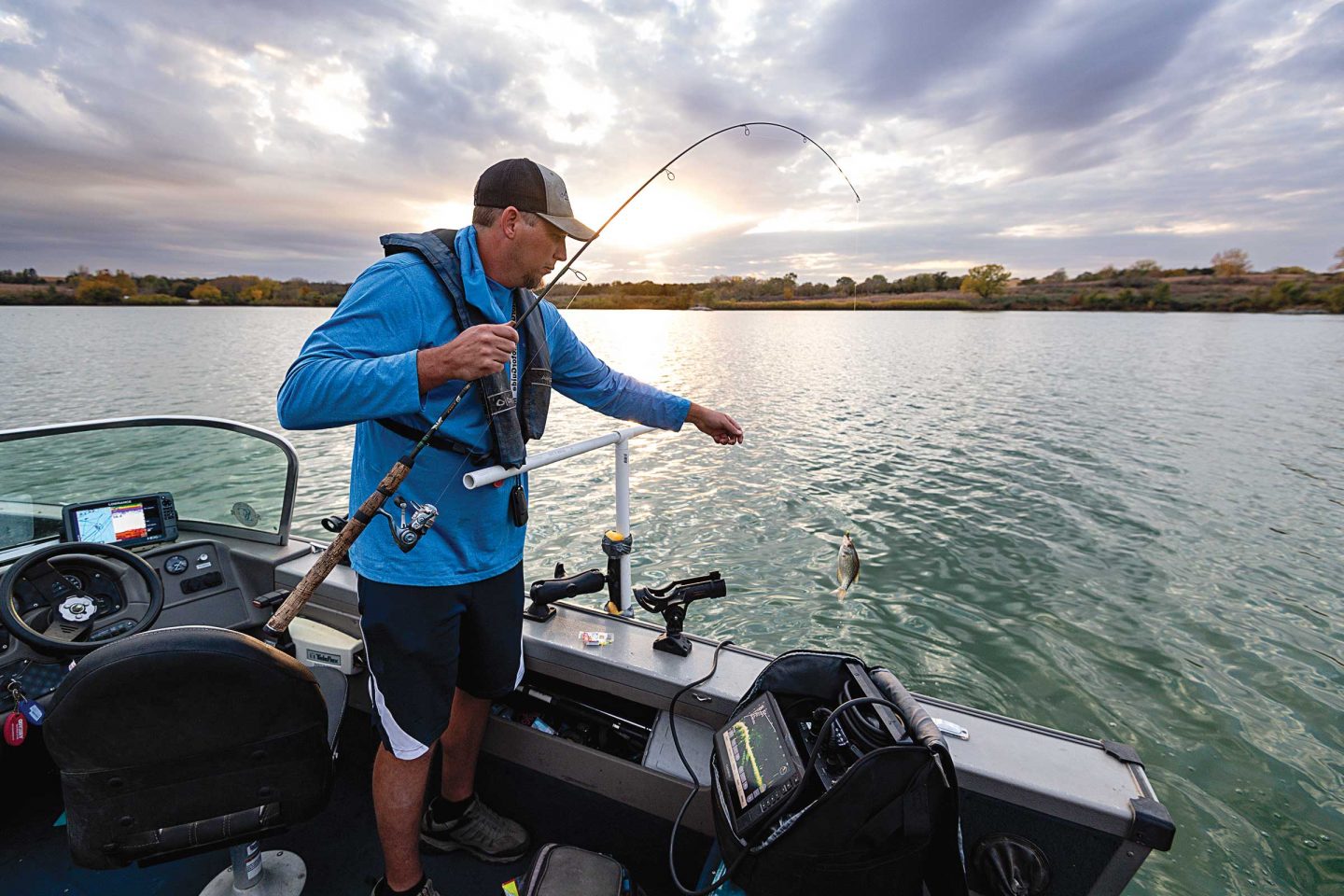
By Eric Fowler
Some call it video game fishing. That it’s cheating. They say fish don’t have a chance, and it will ruin fishing. Others say it’s just another tool in the tacklebox. Whatever the case, most will agree forward-facing or live-imaging sonar is one of the most debated advancements to enter the fishing world.
Forward-facing sonar gives anglers a live, real-time view of the lake bottom, structure and fish under and around their boat or ice hole, as well as their bait or lure. Those who really know how to use it can judge the size and species of the fish, put their bait right in front of its nose and catch it.
All three major marine electronics companies offer their own version of the technology. Garmin was the first, introducing Panoptix 2015. That was followed by Lowrance’s Active Target in 2019 and Humminbird’s MegaLive in 2021. The technology isn’t cheap, with transducers alone running $1,500 and the screen to display it starting at around $750. But each year, more anglers are jumping on board.
Anglers using it to locate big walleyes are dominating the leaderboards of most tournaments on the professional circuits. The same was happening on the pro bass circuits, and late this year, one circuit announced a ban on FFS for 2025, and another limited how much of this technology anglers could have on their boat next year. This is a sport where some boats carry $30,000 in electronics and as many screens as your local sports bar.
Younger anglers who have been immersed in technology throughout their lives have been quick to adopt FFS. And many believe it is attracting some kids who had preferred to stay home and play video games rather than go fishing with mom or dad: Now they get to do both.
Yet whether this technology really helps anglers catch more fish, and whether that additional harvest affects fish populations, is still in question.
Aaron Blank, the southeast district fisheries manager with Game and Parks, has been using the Garmin system for four years. As an angler, he said it’s a game changer, especially when targeting fish that suspend in cover or open water. As a fisheries biologist, he has concerns. With it, he said he has caught more than 1,000 crappies in a year from one of the Salt Valley Lakes near Lincoln, releasing all but a few for the occasional fish fry.
“It changes the way you present your bait and how you approach different structure,” Blank said. Now, instead of ripping his jig through a tree pile blindly, hoping to not get snagged, he can downsize to a 1/32- or 1/64-ounce jig, walk it over the top of a tree he knows is holding fish “and hold it right where the fish are.”
One of the top concerns for Blank and fisheries managers across the country is how the technology will affect bluegill and crappie populations. Considering FFS is still in its infancy, only a handful of studies have looked at its effectiveness.
Kansas conducted one of the first in December 2021, dividing 32 biologists into teams on the 6,800-acre Cedar Bluff Reservoir to fish one side of the lake with FFS on one day and the other side without the next. Anglers caught one more crappie, 2 more fish and slightly larger crappie while they were using it than when they weren’t, a difference deemed statistically insignificant.
Creel surveys in Texas and Arkansas found crappie anglers using FFS caught twice as many fish as those who didn’t, but didn’t harvest twice as many fish. Arkansas’ study also found the length of crappies harvested similar in both groups, showing anglers weren’t using live sonar to “cherry pick” big crappies. The Texas study also surveyed bass anglers and found those using FFS caught only a few more fish, and very few anglers harvest bass.
Blank said that while some aspects of these studies might apply in Nebraska, one part doesn’t. “Down in Texas or Arkansas, where you can grow a 10-inch crappie in a year or two, that’s a lot different than in southeastern Nebraska where it takes 4 to 5 years to grow a 10-inch crappie,” he said. “If people are more successful in catching them, and if they harvest more of the larger crappies, it just takes longer for us to catch up.”
Game and Parks fisheries staff is preparing to launch its own forward-facing sonar study, putting its own spin on what Kansas did. Each of the five districts now has a FFS unit, and biologists are learning how to use them. Starting next spring, they will meet at 225-acre Flanagan Lake in Omaha. Like Kansas’ study, they will spend a half day fishing one side of the lake with FFS and a half day fishing the other side without. The exercise will be repeated in the summer, fall and on the ice, giving them a look at how catch rates could differ throughout the year.

“A lot of studies have been done on 2,000-acre reservoirs or bigger,” Blank said. “FFS likely will not have as big of an effect on a larger body of water as it does on a 100-acre reservoir in the middle of Omaha where you’ve got a big population, heavy pressure and it’s easier to break down water and find fish. What we want to see is in smaller bodies of water what effects will live sonar have?”
Technology has come a long way since the sonar flasher was introduced in 1957 and began replacing a weight on a rope as the depth finder of choice. That flasher allowed anglers to not only know the depth, but also “see” fish beneath them.
More recently, high-resolution down-scan, side-scan and 360-degree sonar have painted an even clearer picture of what lies beneath the surface. Similarly, GPS technology has led to better lake contour maps and helped anglers easily revisit a stump, creek channel or rock pile that seems to always hold fish. Each of these advancements have made it easier for anglers to find fish, but they haven’t always helped them catch more fish.
An old adage in fisheries management says that 10 percent of anglers catch 90 percent of the fish, due in part to time spent on the water learning when, where and how to catch them. Some adopted the technology, and some continue to catch plenty of fish without live sonar. While the 90 percent might catch the most fish, it doesn’t mean they harvest the most fish, said Tony Barada, assistant fisheries administrator at Game and Parks.
“Forward-facing sonar might just catch somebody a limit faster. It doesn’t mean they can keep more fish by any means,” Barada said, noting bag and possession limits still apply.
The technology is a regular topic in monthly Zoom meetings among the heads of fisheries managers nationwide. Some states have discussed outright bans of the technology.
“When it’s reaching that level of decision makers, it is a pretty hot topic,” Barada said, “because we, as agencies, are hearing it from both sides.”
Barada doesn’t see a ban coming due to the simple fact that it would be hard to tell anglers who invested in the technology they can’t use it. But he could see more regulations coming, be it in bag or length limits. Just this year, Mississippi reduced bag limits on five of its prime crappie waters in response to increased use of live sonar, which jumped from 20 percent of anglers in 2021 to 70 percent in 2023.
Game and Parks creel surveys began measuring FFS use in 2023. With only four lakes surveyed, use has ranged from 9 percent of boat anglers at Cunningham Lake to 21 percent at Sherman Reservoir. As those numbers increase, fisheries managers will be keeping a close eye on the resource.
“It’s a technological advancement that we can manage and overcome through regulations if we view it as having a large impact,” Barada said.
